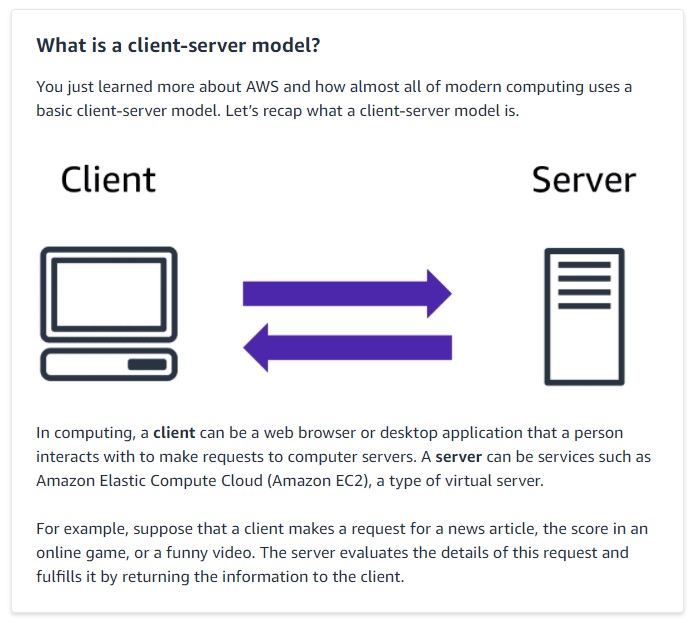AWS Amazon Web Services
NOTES
RANGE OF SERVICES:
Compute
Storage
Network Security
SOLUTIONS
Blockchain
Machine Learning
Artificial Intelligence (AI)
Robot Development Platforms
TOOLSETS
Video Production Management Systems
Orbital Satellites
FUNDAMENTAL CLOUD COMPUTE MODEL
Client Server Model
Client makes a request to the server (Amazon Elastic Compute Cloud or Amazon EC2 – an instance or virtual server). With permissions (validate, legitimate) the server responds to the request.
KEY CONCEPT – You Only Pay For What You Use. You don’t prepay.

NOTES
CLOUD COMPUTING The on demand delivery of IT resources on the internet with pay-as-you-go pricing
Use the storage you need when you need it – flexibility. Scalable. Not available with managing your own data center.
THE ENGINE – the undifferentiated heavy lifting of IT; tasks that are common, repetitive and time consuming can be handled with AWS.
From AWS:
Deployment models for cloud computing
When selecting a cloud strategy, a company must consider factors such as required cloud application components, preferred resource management tools, and any legacy IT infrastructure requirements.
The three cloud computing deployment models are cloud-based, on-premises, and hybrid.
Cloud-based deployment
- Run all parts of the application in the cloud.
- Migrate existing applications to the cloud.
- Design and build new applications in the cloud.
In a cloud-based deployment model, you can migrate existing applications to the cloud, or you can design and build new applications in the cloud. You can build those applications on low-level infrastructure that requires your IT staff to manage them. Alternatively, you can build them using higher-level services that reduce the management, architecting, and scaling requirements of the core infrastructure.
For example, a company might create an application consisting of virtual servers, databases, and networking components that are fully based in the cloud.
On-premises deployment
- Deploy resources by using virtualization and resource management tools.
- Increase resource utilization by using application management and virtualization technologies.
On-premises deployment is also known as a private cloud deployment. In this model, resources are deployed on premises by using virtualization and resource management tools.
For example, you might have applications that run on technology that is fully kept in your on-premises data center. Though this model is much like legacy IT infrastructure, its incorporation of application management and virtualization technologies helps to increase resource utilization.
Hybrid deployment
- Connect cloud-based resources to on-premises infrastructure.
- Integrate cloud-based resources with legacy IT applications.
In a hybrid deployment, cloud-based resources are connected to on-premises infrastructure. You might want to use this approach in a number of situations. For example, you have legacy applications that are better maintained on premises, or government regulations require your business to keep certain records on premises.
For example, suppose that a company wants to use cloud services that can automate batch data processing and analytics. However, the company has several legacy applications that are more suitable on premises and will not be migrated to the cloud. With a hybrid deployment, the company would be able to keep the legacy applications on premises while benefiting from the data and analytics services that run in the cloud.
Benefits of cloud computing
Consider why a company might choose to take a particular cloud computing approach when addressing business needs.
Trade upfront expense for variable expense
Upfront expense refers to data centers, physical servers, and other resources that you would need to invest in before using them. Variable expense means you only pay for computing resources you consume instead of investing heavily in data centers and servers before you know how you’re going to use them.
By taking a cloud computing approach that offers the benefit of variable expense, companies can implement innovative solutions while saving on costs.
Stop spending money to run and maintain data centers
Computing in data centers often requires you to spend more money and time managing infrastructure and servers.
A benefit of cloud computing is the ability to focus less on these tasks and more on your applications and customers.
Stop guessing capacity
With cloud computing, you don’t have to predict how much infrastructure capacity you will need before deploying an application.
For example, you can launch Amazon EC2 instances when needed, and pay only for the compute time you use. Instead of paying for unused resources or having to deal with limited capacity, you can access only the capacity that you need. You can also scale in or scale out in response to demand.
Benefit from massive economies of scale
By using cloud computing, you can achieve a lower variable cost than you can get on your own.
Because usage from hundreds of thousands of customers can aggregate in the cloud, providers, such as AWS, can achieve higher economies of scale. The economy of scale translates into lower pay-as-you-go prices.
Increase speed and agility
The flexibility of cloud computing makes it easier for you to develop and deploy applications.
This flexibility provides you with more time to experiment and innovate. When computing in data centers, it may take weeks to obtain new resources that you need. By comparison, cloud computing enables you to access new resources within minutes.
Go global in minutes
The global footprint of the AWS Cloud enables you to deploy applications to customers around the world quickly, while providing them with low latency. This means that even if you are located in a different part of the world than your customers, customers are able to access your applications with minimal delays.
================================================================
AWS certified cloud practitioner
Certified cloud security professional (CCSP)
Certified data privacy solutions engineer (CDPSE)
Certified data professional (CDP)
Certified ethical hacker (CEH)
Certified information security manager (CISM)
Certified information systems security professional (CISSP)
Cisco certified internetwork expert (CCIE)
Cisco certified network professional (CCNP)
CompTIA (A+, Cloud+, Security+)
Microsoft Certified Azure Solutions Architect
Microsoft certified solutions associate/expert (MCSA/MCSE)
Information technology infrastructure library (ITIL)
Oracle database and MySQL administration certifications
Project management professional (PMP)
Salesforce certified development lifecycle and deployment designer
